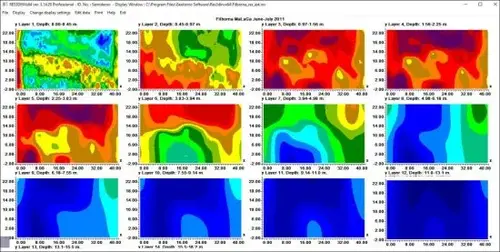Geotomo Software RES3DINVx64 Pro 3.14.20
Two-dimensional (2D) electrical imaging surveys are now widely used to map areas of moderately complex geology where conventional 1D resistivity sounding and profiling techniques are inadequate. The results from such surveys are usually plotted in the form of a pseudosection (Figure 1a) which gives an approximate but distorted picture of the subsurface geology.

The RES2DINVx32/x64 programs use the smoothness-constrained Gauss-Newton least-squares method inversion technique to produce a 2D model of the subsurface from the apparent resistivity data alone. It is completely automatic and the user does not even have to supply a starting model. This program has been optimised for the inversion of large data sets. The use of available memory is optimised so as to reduce the computer time by minimising disk swapping. On a modern microcomputer, the inversion of a single pseudosection is usually completed within seconds to minutes. Four different techniques for topographic modelling are available in this program. Together with the free 2D forward modeling program RES2DMOD, it forms a complete 2D resistivity forward modeling and inversion package.
The program will automatically choose the optimum inversion parameters for a particular data set. However, the parameters which affects the inversion process can be modified by the user. The smoothing filter can be adjusted to emphasize resistivity variations in the vertical or horizontal directions. Two different variations of the smoothness constrained least-squares method are provided; one optimised for areas where the subsurface resistivity varies in a smooth manner (such as chemical plumes), and another optimised for areas with sharp boundaries (such as massive ore bodies). A robust data inversion option is also available to reduce the effect of noisy data points. Resistivity information from borehole and other sources can also be included to constrain the inversion process. The complex resistivity method (Kenma, A., Binley, A., Ramirez, A. and Daily, W., 2000. Complex resistivity tomography for environmental applications. Chemical Engineering Journal, 77, 11-18.) is used for IP data inversion.
The figure below shows an example from an electrical imaging survey in an area with fairly complex subsurface geology and significant surface topography. This survey was carried out across a circular mound which is thought to contain some important Irish archaeological burial chambers (Waddell, J. and Barton, K, 1995, Seeing beneath Rathcroghan. Archaeology Ireland, Vol. 9, No. 1, 38-41.). The inversion of this data set, which has 67 electrode positions and 339 data points, takes seconds on a modern PC.
File size: 108 MB
Download
http://s9.alxa.net/one/2024/10/RES3DINV.Pro.3.14.20.rar
Two-dimensional (2D) electrical imaging surveys are now widely used to map areas of moderately complex geology where conventional 1D resistivity sounding and profiling techniques are inadequate. The results from such surveys are usually plotted in the form of a pseudosection (Figure 1a) which gives an approximate but distorted picture of the subsurface geology.

The RES2DINVx32/x64 programs use the smoothness-constrained Gauss-Newton least-squares method inversion technique to produce a 2D model of the subsurface from the apparent resistivity data alone. It is completely automatic and the user does not even have to supply a starting model. This program has been optimised for the inversion of large data sets. The use of available memory is optimised so as to reduce the computer time by minimising disk swapping. On a modern microcomputer, the inversion of a single pseudosection is usually completed within seconds to minutes. Four different techniques for topographic modelling are available in this program. Together with the free 2D forward modeling program RES2DMOD, it forms a complete 2D resistivity forward modeling and inversion package.
The program will automatically choose the optimum inversion parameters for a particular data set. However, the parameters which affects the inversion process can be modified by the user. The smoothing filter can be adjusted to emphasize resistivity variations in the vertical or horizontal directions. Two different variations of the smoothness constrained least-squares method are provided; one optimised for areas where the subsurface resistivity varies in a smooth manner (such as chemical plumes), and another optimised for areas with sharp boundaries (such as massive ore bodies). A robust data inversion option is also available to reduce the effect of noisy data points. Resistivity information from borehole and other sources can also be included to constrain the inversion process. The complex resistivity method (Kenma, A., Binley, A., Ramirez, A. and Daily, W., 2000. Complex resistivity tomography for environmental applications. Chemical Engineering Journal, 77, 11-18.) is used for IP data inversion.
The figure below shows an example from an electrical imaging survey in an area with fairly complex subsurface geology and significant surface topography. This survey was carried out across a circular mound which is thought to contain some important Irish archaeological burial chambers (Waddell, J. and Barton, K, 1995, Seeing beneath Rathcroghan. Archaeology Ireland, Vol. 9, No. 1, 38-41.). The inversion of this data set, which has 67 electrode positions and 339 data points, takes seconds on a modern PC.
File size: 108 MB
Download
http://s9.alxa.net/one/2024/10/RES3DINV.Pro.3.14.20.rar
